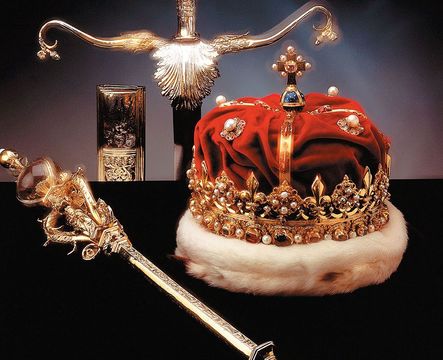
The gift of a golden scepter by Pope Alexander VI to King James IV in 1494 began the priceless collection known as the Honours of Scotland. After a long and colorful history, the Honours of Scotland rest on display in Edinburgh Castle atop the Royal Mile in Scotland’s capital city.
Princes born in exile, elegant monsters from unexplored depths, woven woolen fabric and the music squeezed from a sheep’s stomach; the Scots have placed their affections in some strange places throughout their battle-worn history
Some, such as King Macbeth and William Wallace, have made their way from history to mythology; others—the Stone of Destiny—for instance, came from mythology to a very solid reality. Only the “Honours” have made the journey from history to mythology and back again to reality.
Given the stubbornly contrary nature of the Scots, we might not be surprised that their Honours, the Royal Regalia or Scottish Crown Jewels were made far from Scottish shores, came to replace a king, and were once kept safe in a minister’s bed!
Read more
Asked to imagine Crown Jewels, people the world over will picture the crown and scepter on display at the Tower of London, but these are relative newcomers in terms of British Royal regalia. For real antiquity, we need to look several hundred miles to the north where the Honours are lovingly displayed in Edinburgh Castle—but their journey to the hearts of the Scottish people actually began far from the mist and mountains. It began in Rome.
In the 13th and 14th centuries, while kingdoms waxed and waned, while neighbors slaughtered each other over continually changing borders, the power came at the point of a sword or rode on lumbering war horses. One power, however, had authority over kings, princes, and freedom fighters: the Vatican.
The British Isles were a collection of Catholic countries and feared the ultimate sanction of excommunication. King Robert I of Scotland, or The Bruce, had defied the papacy in his quest for power, but constantly sent envoys to Rome in attempts to win back favor. What use, after all, was power in this life if you were denied heaven in the next?
As a result of these entreaties, Scotland was declared a “special daughter” of the Holy See.
Gifts from the pope to any nation brought a significance and prestige well beyond the monetary value of the objects themselves. They were honors from a power that claimed a higher kingdom than any on Earth.
The oldest of the papal gifts that would eventually constitute the Scottish Regalia was presented to King James IV by Pope Alexander VI in 1494. The scepter is a golden hexagonal rod, topped by a finial ball of rock crystal. The crystal is supported by golden dolphins and depictions of Saint Andrew, Saint James and the Virgin and Child.
Thirteen years later Pope Julius II presented James with a “Blessed Sword.” Not such a surprising gift, perhaps, from “the warrior Pope.”
The Blessed Sword and its gold-and-silver scabbard were crafted by Dominico da Sutri during the High Renaissance, reflecting the ornately decorative style of the time. The quillons of the handle are stylized dolphins, representing the church. The blade has etched upon it, “JULIUS II PONT MAX,” or Julius II Supreme Pontiff. A woven silk-and-gold-thread sword belt complements the set.
No Regalia would be complete without a crown, and for this the Scots looked closer to home.
Tradition has it that The Bruce was crowned (in a hurry) with a rude circle of gold. Kings after him had the circle adorned with fleur de lis and, judging from the number of times it was repaired, it was treated with no great respect.
Next to the sword and scepter, used at the crowning of James V’s young wife, Mary, the current crown must have looked shabby indeed, for James immediately had it remodeled.
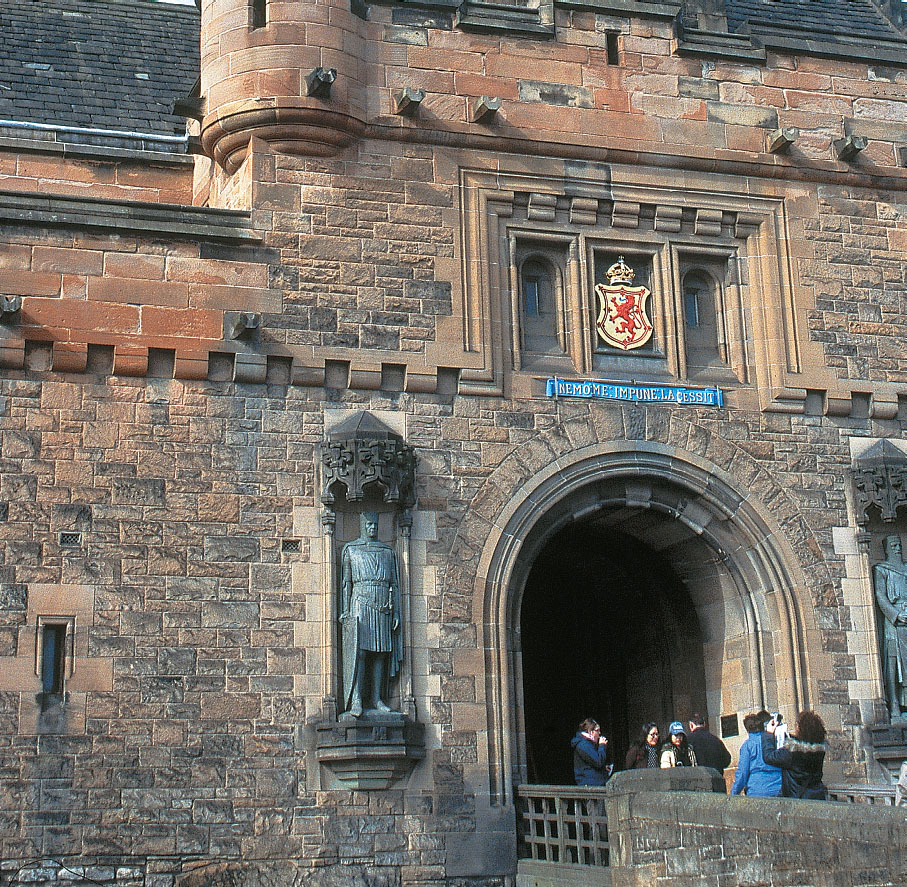
DANA HUNTLEY
John Mossman, an Edinburgh gold-smith, was given the old crown, 41 extra ounces of Scottish gold, 22 additional precious stones and 68 pearls, and was tasked with creating a crown the king would be proud to wear. To make the 4 pounds of gold and jewels easier to wear, James ordered a silk, satin and fur bonnet fixed to the inside.
Days after the birth of his daughter, James V died. The country was at war, so the infant was smuggled to safety in Stirling Castle. There, baby Mary was anointed queen. The scepter was placed in her tiny hand, the sword laid across her and the crown lowered to her forehead. Throughout the first use of the Honours of Scotland at a coronation, Mary Queen of Scots cried continuously.
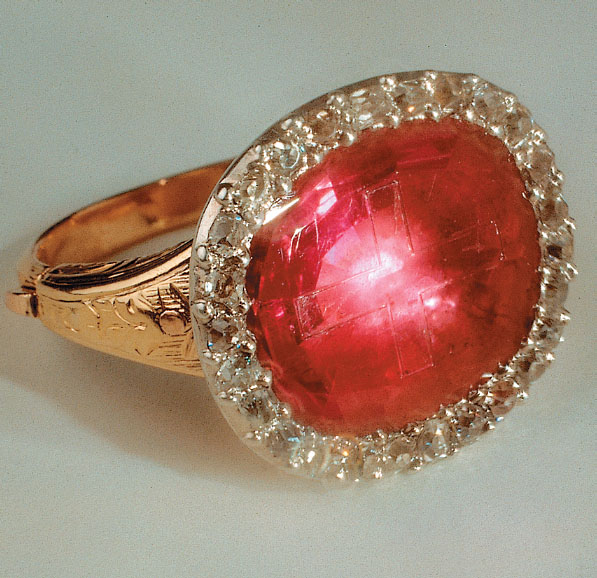
HISTORIC SCOTLAND, EDINBURGH
When her son, James VI, was less than a year old, his mother was forced to abdicate, and he became the second infant crowned by the Honours. For the next 25 years, James VI ruled Scotland, until the death of Elizabeth I of England tantalized him with the prospect of greater riches and higher estate. As James I of England, he paid scant regard to the land of his birth, and in his absence the Honours took on a more royal role, representing the king at the Scottish Parliament, the tapping of each new act by the scepter giving royal assent.
If James treated Scotland with disregard, his son Charles I treated it with blatant disrespect, only traveling north for his Scottish coronation eight years after acceding to the English throne. Lacking the diplomatic talents of his father, Charles set about making enemies and sowing the seeds of the English Civil War.
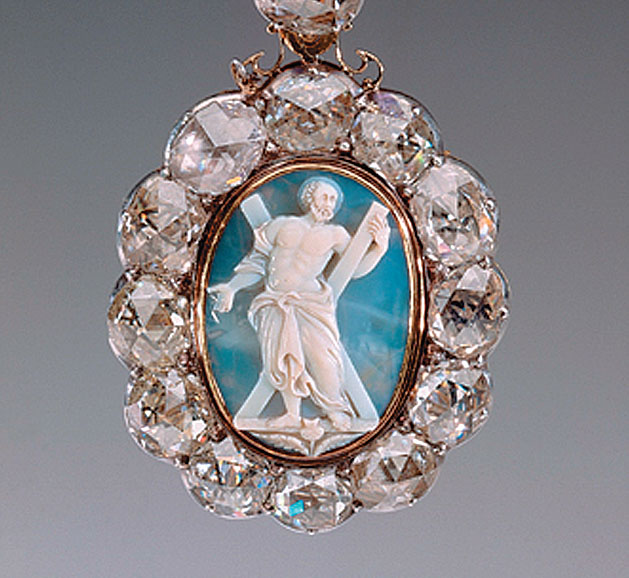
HISTORIC SCOTLAND, EDINBURGH
Had they loved him more, the Scots might not have handed Charles over to Oliver Cromwell, but they could never have foreseen the execution of a king. As Cromwell set about destroying the monarchy and all its symbols, Scotland immediately proclaimed the harried young prince King Charles II, on the same Scone hill where once Bruce had been crowned. Cromwell was furious. He had already destroyed the English Crown Jewels and, next to the king himself, the Honours were the most potent symbol of monarchy remaining.
A ragged and desperate band of Scots soldiers rode ahead of Cromwell’s men with the regalia, finally stopping at Dunottar Castle off the coast of Aberdeenshire. Surrounded by sea on three sides and approached by a narrow, precipitous path, Dunottar had been unassailable in previous generations, and the 70 soldiers defended their treasure for eight months.
Eventually, Cromwell’s commanders called for cannons, and the bombardment of the castle began. When Scotland’s soldiers could hold out no longer, the common folk stepped up and did their bit.
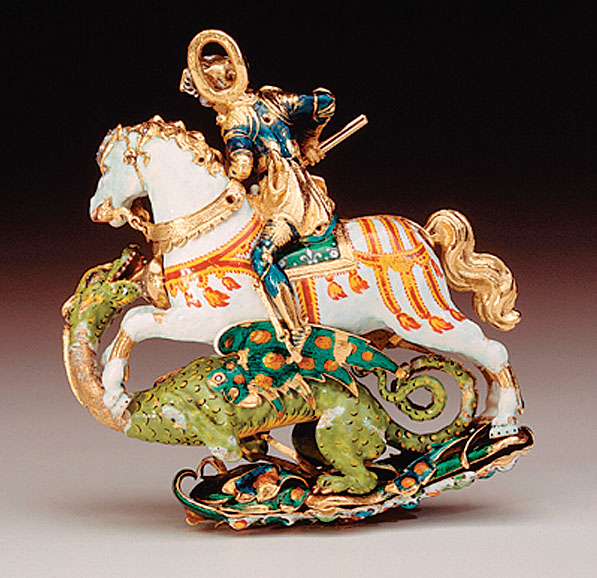
The royal bling of the Stewart Jewels includes this diamond-cased ruby ring, the St. Andrew Jewel and the Great George collar badge. HISTORIC SCOTLAND, EDINBURGH
Christine Granger, the local minister’s wife, obtained permission from the commanding English officer to visit the lady of the castle. After her visit, the same officer assisted Mrs. Granger and her servant in mounting their cart. If only this fine gentleman had known—the crown and the scepter were under her clothes! The sword and scabbard, broken now to disguise their length, were wrapped in the bale of flax her servant carried.
Perhaps thinking there are few places more sacrosanct than a minister’s bed, the Rev. James Granger kept the Honours hidden there for several weeks. For the rest of Cromwell’s reign, they were buried under flagstones in the village church, with the minister and his wife digging them up at midnight once a month to clean and polish them.
After Cromwell’s death, the Honours were restored to Charles II, but they would never again be used to crown a monarch. Instead, they became the embodiment of the Crown in Scotland, their principal roles being at the opening of each session of the Scottish Parliament.
The Scottish Parliament, however, was not to last. With the Acts of Union of 1707, both English and Scottish parliaments were dissolved. The difference for English parliamentarians must have been minimal with their institution being immediately recreated as the British Parliament. In Scotland, it was a more somber occasion, marked as “the end of a long sang.”
The Honours now had no use, symbolic or otherwise. A poem composed for the crown declared:
I, royal diadem, relinquished
stand
By all my friends and robbed of
my land
So left bereft of all I did
command.
They were locked in an oak chest and placed in Edinburgh Castle’s Crown Room. The door was bricked up. From here on the Honours temporarily left the real world and slipped into the lands of myth, rumor, and even propaganda.
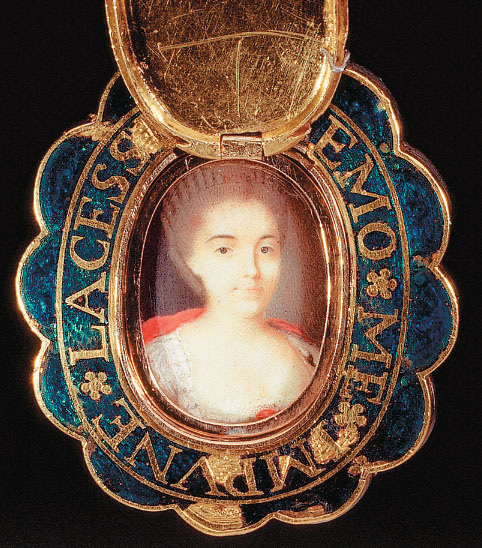
HISTORIC SCOTLAND, EDINBURGH
With succeeding garrisons and commanding officers holding the castle, the memory of the Honours was all but lost. When, in 1794, the lieutenant governor of the castle opened the room to look for some papers, he saw a dusty chest in a corner and gave it a shake. Having no authority to open it and deciding it was empty anyway, he left and had the doorway bricked up again.
Almost invisible they may have been, but that didn’t mean they could not be used. Scottish separatists, tired of London rule, declared the Honours were in the Tower of London being shown to a chosen few…they had been smuggled to France…they had been melted down. Each option guaranteed to fan the flame of nationalism in the Scottish breast.

HISTORIC SCOTLAND, EDINBURGH
In an attempt to calm this unrest, the author Sir Walter Scott petitioned the Prince Regent (the future George IV) for permission, searched for and found the Honours.
Such was Scott’s facility for words that centuries later he is remembered with statues in Edinburgh and New York’s Central Park. But as he watched the chest pried open he could “hardly express” his feelings. Scott knew well the upheaval that might be caused should the chest be found to be empty.
“It was evident,” he wrote, “the removal of Regalia might have greatly irritated people’s minds here and offered a fair pretext of breaking the Union.”
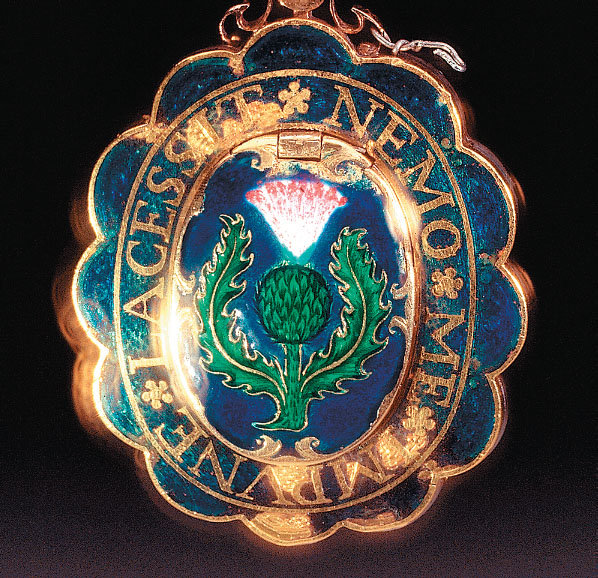
The diamond-encrusted knight is the flashy front of the Great George bauble. He is flanked by an enamel miniature that hangs as a medallion. HISTORIC SCOTLAND, EDINBURGH
The echo of the workmen’s tools had half convinced Scott the chest would be empty, but leaning deep into the shadows, he lifted aside a woolen blanket and withdrew the sword. It was, he wrote: “A most beautiful piece….The scabbard is richly decorated with filigree work of silver, double gilded…executed in a taste worthy of that classical age.” Then, with masterly understatement Scott informs posterity, “The fate of these Regalia, which his Royal Highness’s goodness has thus restored to light and honour has on one or two occasions been singular enough.”
His next concern was that the Honours should be made available to public gaze—for a reasonable charge! The Honours and the Stewart Jewels that accompanied them were put on display in the same Crown Room where they had slumbered for 111 years. Since then they have left their home only thrice.
In 1939, with the Nazi storm raging across Europe, the Honours were taken into the castle cellars and covered with sandbags. When a German invasion began to look like a realistic possibility, more imaginative measures were needed. The Crown and Stewart Jewels were placed in a zinc-lined case and buried beneath a castle latrine. The scepter and sword of the state were bricked up in a wall. The location of these hiding places was sent to the Governor-General in faraway Canada.
After the 1953 coronation of Queen Elizabeth II, a National Service of Thanksgiving was held. Scotland’s highest-ranking nobles, bareheaded out of respect for their precious burdens, carried the Honours from the castle to the High Kirk of St. Giles, where they were received by Her Majesty.
On Thursday, July 1, 1999, Queen Elizabeth II opened the first session of the Scottish Parliament to sit for 300 years. In a reminder that they are vastly more than museum pieces, the Honours, which had seen the closure of the last parliament, were laid before Her Majesty in the new parliament building.
Having survived the vagaries and brutality of centuries of Scottish history, having been held in the highest esteem, buried in a church and entombed in a dusty oak coffin, the Honours were once again center stage in history, back at the heart of Scottish life.
* Originally published in January 2007.





Comments